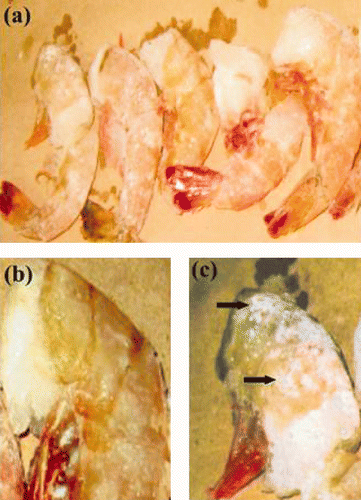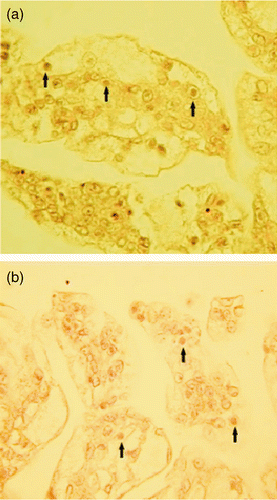Figures & data
Figure 1. Preliminary frozen shrimp section analysis. (a): Frozen shrimp sections showed individual samples isolated. (b),(c): Primary viral infection evaluation by visual macroscopic WSSV symptoms in uninfected and infected shrimp samples, respectively. Arrows indicate the white spots characteristic of this disease.
Figura 1. Análisis preliminar de las secciones congeladas de camarón. (a): Sección de camarón congelada mostrando los camarones individuales aislados. (b),(c): Evaluación preliminar de la infección viral por síntomas de WSSV macroscópicos visuales en muestras no infectadas e infectadas, respectivamente. La flecha indica la característica mancha blanca de la enfermedad.

Table 1. Screening and incidence of PCR-positive reactions for white spot syndrome virus in frozen shrimp stocks imported to Mexico.
Tabla 1. Búsqueda e incidencia de reacciones de PCR positivas al síndrome de la mancha blanca en lotes de muestras congeladas de camarón importadas a México.
Figure 2. Representative WSSV electrophoretic band patterns from frozen shrimp sections. There are presented two representative WSSV analyses conduced in frozen sections from main and more abundant shrimps stocks of this study. Lanes M: 1 kb ladder; Lane 9: water template (negative control); Lane 10: WSSV-positive cDNA (401 bp-positive control); Lane 11: PCR-Reaction internal control (602 bp-positive control); Lanes 1 and 2: positive samples from P. aztecus imported from USA; Lanes 3 and 4: Samples from L. vannamei produced in Venezuela; Lanes 5 and 6: Samples from L. vannamei produced in USA; Lanes 7 and 8: Samples from Penaeus duorarum produced in USA.
Figura 2. Patrón de bandas electroforético característico del WSSV obtenido a partir de secciones de camarón congeladas. Se presentan dos análisis representativos del diagnostico WSSV realizados en las principales y más abundantes secciones de camarón congeladas. Carril M: Marcador 1 kb; Carril 9: Solo agua (testigo negativo); Carril 10: ADNc positivo al WSSV (Testigo positivo de 401 pb); Carril 11: Testigo interno de la reacción de PCR (Testigo positivo 602 pb). Carriles 1 y 2; Muestras positivas de P. aztecus importado desde los EUA. Carriles 3 y 4; Muestras de L. vannamei producidas en Venezuela. Carriles 5 y 6; Muestras de L. vannamei producidas en EUA. Carriles 7 y 8; Muestras de Penaeus duorarum producidos en EUA.

Figure 3. Cuticular epithelium of the pleopod infected with WSSV. (a) and (b): Paraffin sections from L. aztecus, × 400. Arrows indicate heavily infected cuticular epithelial cells showing large basophilic inclusions characteristic of WSSV infection.
Figura 3. Epitelio cuticular obtenido de tejido de pleopodos infectados con WSSV. (a) and (b): Secciones de parafina obtenidas de muestras de P. aztecus. × 400. Las flechas indican células de epitelio cuticular mostrando las grandes inclusiones basófilas características de la infección por WSSV.
